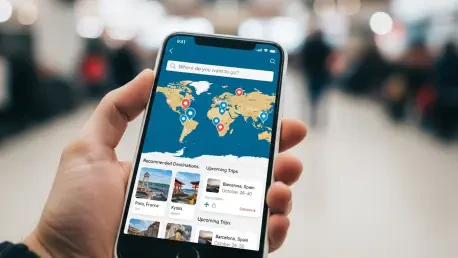The Gulf Cooperation Council (GCC) region, encompassing Bahrain, Kuwait, Oman, Qatar, Saudi Arabia, and the UAE, is undergoing a remarkable transformation in the travel and tourism sector, driven by a surge in digital innovation and ambitious government initiatives. With programs like Saudi Arabia’s Vision 2030 and the UAE’s Tourism Strategy 2040 setting the stage for seamless, tech-driven travel experiences, the demand for cutting-edge travel apps has never been higher. As smartphones become the primary tool for trip planning, travelers in the GCC are seeking mobile solutions that simplify booking, navigation, and local discovery while resonating with cultural nuances and regional preferences. The MENA travel and tourism market, projected to reach $4.80 billion by 2030 according to Statista, presents a lucrative opportunity for businesses to tap into this growing demand. Developing a next-generation travel app tailored for this market requires more than just technical expertise; it demands a deep understanding of local payment systems, Arabic language integration, and compliance with regional regulations. This article delves into the strategic steps, essential features, cost considerations, and challenges involved in crafting an app that meets the unique needs of GCC travelers, ensuring a personalized and efficient user experience.
1. Understanding the Digital Travel Revolution in the GCC
The GCC region is at the forefront of a digital travel revolution, fueled by government-led initiatives aimed at enhancing tourism through technology. Programs such as Saudi Arabia’s Vision 2030 and the UAE’s Tourism Strategy 2040 prioritize the integration of digital tools to create seamless travel experiences. A notable example is the Unified GCC Tourist Visa, which allows visitors to explore all six GCC countries with a single online application, simplifying cross-border travel. Additionally, partnerships like the UAE’s collaboration with UN Tourism to develop digital platforms for better communication among member countries highlight the region’s commitment to modernizing tourism. This environment creates fertile ground for travel app development, as businesses can leverage these advancements to offer innovative solutions that align with governmental goals and traveler expectations.
Beyond policy-driven changes, the GCC is witnessing a surge in local innovation, with over 150 travel-related startups in the UAE alone contributing to a vibrant ecosystem. These startups are crafting mobile solutions tailored to diverse traveler needs, from streamlined booking systems to personalized trip planning tools. The emphasis on AI-powered technologies, mobile-first designs, and integration with local services is redefining how travel is experienced in the region. As the GCC continues to invest heavily in digital infrastructure, it sets new global benchmarks for travel app functionality, pushing developers to focus on personalization, efficiency, and security to meet the sophisticated demands of both local and international users.
2. Conducting Market Exploration and Needs Assessment
Embarking on travel app development for the GCC market begins with comprehensive market research to grasp the unique dynamics of the region, which is essential for success. This involves analyzing existing travel apps to identify gaps and opportunities that can be addressed with innovative features. Creating detailed user personas is crucial to understanding the preferences and pain points of GCC travelers, whether they are locals, expats, or tourists. Examining local regulations, payment habits, and cultural expectations ensures that the app aligns with regional standards. A thorough needs assessment at this stage lays a solid foundation, helping developers avoid costly missteps and ensuring that the final product resonates with the target audience in terms of functionality and relevance.
Equally important is the study of competitor offerings to pinpoint areas for differentiation, which can provide a significant edge in the market. For instance, understanding how current apps handle multi-language support or local payment integrations can reveal shortcomings that a new app could address. Gathering insights into user expectations, such as the demand for real-time updates or culturally relevant recommendations, allows for a more targeted development approach. This phase also involves mapping out compliance requirements specific to the GCC, including data privacy laws and travel regulations across different countries. By documenting these findings clearly, businesses can streamline the subsequent stages of design and development, ensuring that every feature serves a purpose tailored to regional travelers.
3. Crafting Interface and Experience Design
Designing an intuitive and culturally relevant user interface (UI) and user experience (UX) is a pivotal step in creating a travel app for the GCC market. This process starts with developing wireframes and prototypes to visualize how users will interact with the app, allowing stakeholders to refine navigation and layout before coding begins. Incorporating design elements that reflect regional aesthetics, such as right-to-left (RTL) text for Arabic speakers, ensures the app feels familiar and accessible to local users. Multi-language support, particularly for Arabic and English, must be seamlessly integrated to cater to a diverse user base, including expatriates and international tourists, enhancing overall usability and engagement.
Attention to accessibility is also critical during this phase to ensure the app accommodates users with varying needs, and testing early design iterations with focus groups from the GCC region can provide valuable feedback on cultural appropriateness and ease of use. Prioritizing a clean, user-friendly interface that minimizes friction in tasks like booking or trip planning helps retain users in a competitive market. A well-executed design not only boosts user satisfaction but also reduces the likelihood of costly redesigns later in the development cycle. By focusing on these aspects, developers can create an app that not only looks appealing but also functions intuitively for its intended audience across the GCC.
4. Selecting the Right Technology Framework
Choosing an appropriate technology stack is a cornerstone of building a scalable and efficient travel app for the GCC market. For frontend development, options like Flutter or React Native offer cross-platform compatibility, enabling the app to reach users on both iOS and Android with a single codebase. On the backend, frameworks such as Node.js or .NET, paired with cloud hosting solutions, provide the scalability needed to handle spikes in user traffic during peak travel seasons. Integrating local payment systems like Mada or PayTabs, alongside travel APIs for bookings and updates, ensures that the app delivers seamless transactions and real-time information tailored to regional needs.
The selection process must also consider long-term maintenance and the ability to incorporate emerging technologies like AI for personalized recommendations. Developers should evaluate the compatibility of chosen tools with GCC-specific requirements, such as multi-currency support and compliance with data protection regulations. A robust tech framework not only supports current functionalities but also allows for future expansions, such as adding AR experiences or gamification features. By prioritizing flexibility and performance in this phase, businesses can build an app capable of adapting to evolving traveler expectations and technological advancements within the dynamic GCC market.
5. Executing the App Building Stage
The development phase of a travel app for the GCC market requires a structured approach, often employing agile methodologies to ensure flexibility and quality. This stage involves breaking the project into manageable sprints, allowing for regular progress checks and iterative improvements. Developers integrate external services such as booking engines, mapping tools, and review platforms, ensuring these connections cater to the expectations of local travelers. Continuous testing during sprints helps catch issues early, maintaining a high standard of functionality and reliability. Close collaboration between developers, designers, and product managers keeps the project aligned with business objectives and user needs.
Focusing on regional customization during development is essential for creating a product that stands out. This includes embedding features like real-time notifications for flight updates or culturally relevant travel suggestions, which are particularly valued by GCC users. Regular feedback loops with stakeholders help refine features and ensure that the app addresses specific pain points, such as navigating diverse payment systems across the region. By maintaining a disciplined development schedule and prioritizing user-centric design, this phase ensures that the app not only meets technical standards but also delivers a tailored experience that resonates with travelers in the GCC.
6. Ensuring Testing and Quality Verification
Thorough testing and quality assurance (QA) are indispensable before launching a travel app in the GCC market. This phase involves evaluating the app across various devices and operating systems to confirm consistent performance, security, and compatibility. Stress tests simulate high-traffic scenarios, such as peak holiday seasons, to ensure the app can handle large user volumes without crashing. Security assessments protect sensitive user data, like payment details and personal information, by identifying vulnerabilities. Addressing bugs and glitches at this stage prevents negative user experiences that could harm the app’s reputation after launch.
Compliance with GCC-specific regulations, including data protection laws, must also be verified during testing. This involves ensuring that user data is stored and processed according to regional standards, which helps build trust among users. Engaging QA teams to conduct usability testing with a diverse group of GCC travelers can uncover interface issues or cultural misalignments that might otherwise go unnoticed. A rigorous QA process not only guarantees a polished product but also minimizes the risk of costly fixes after deployment. By prioritizing reliability and regional relevance, developers can deliver an app that users depend on for their travel needs across the region.
7. Managing Deployment and Ongoing Support
Launching a travel app in the GCC market is not the end but the beginning of a continuous improvement cycle that demands ongoing attention and adaptation. Initial deployment often includes beta testing with a select group of users to gather real-world feedback on functionality and performance. Optimizing the app for visibility on app stores through targeted keywords and localized descriptions increases discoverability among GCC travelers. Post-launch, monitoring user interactions and reviews provides insights into areas for enhancement, ensuring the app remains relevant as travel trends evolve. Regular updates address bugs and introduce new features to keep users engaged in a competitive landscape.
Ongoing support is vital to adapt to the dynamic nature of the GCC travel sector, where seasonal demands and user preferences can shift rapidly, requiring businesses to stay agile and responsive. Maintenance tasks, such as security patches and performance optimizations, safeguard the app against emerging threats and ensure smooth operation. Establishing a feedback mechanism allows users to report issues or suggest improvements, fostering a sense of community and loyalty. By committing to consistent post-launch care, businesses can sustain user trust and position their app as a go-to solution for travel planning and exploration throughout the GCC region.
8. Defining Essential Features for GCC Travel Apps
A successful travel app in the GCC market must include core features that cater to the practical needs of travelers while reflecting regional characteristics. Multi-language support, particularly for Arabic and English, ensures accessibility for locals, expats, and tourists alike. Integration with regional payment gateways like Mada and PayTabs facilitates secure and convenient transactions. Real-time booking capabilities for flights and hotels, coupled with instant confirmations, streamline the planning process. Tools for itinerary management allow users to organize trips and track schedules in one place, while live updates on flight delays or gate changes keep travelers informed and stress-free.
Additional features enhance usability and user satisfaction in unique ways, making travel planning and exploration seamless for a diverse audience. Advanced search filters enable quick customization of travel options, helping users find the best flights, hotels, or tours. Built-in maps and GPS navigation assist in exploring destinations effortlessly, especially for international visitors unfamiliar with the region. A system for user reviews and ratings builds trust by offering insights into hotels and activities from fellow travelers. Promotions and discounts encourage repeat usage, while offline functionality ensures access to critical information like tickets and plans without internet connectivity. These elements collectively create a comprehensive tool tailored for the diverse GCC audience.
9. Incorporating Advanced Features for a Competitive Edge
To stand out in the crowded GCC travel app market, integrating advanced functionalities can significantly elevate user engagement and create a standout experience. AI-driven trip recommendations personalize travel suggestions based on user history and preferences, making each interaction unique. Augmented reality (AR) tools provide immersive previews of landmarks or accommodations in 3D, enriching the planning experience. Multi-currency pricing, dynamically adjusted for demand or special offers in local currencies like AED or SAR, caters to the region’s diverse economic landscape. Intelligent itinerary planning automates route optimization and activity scheduling, saving time for users.
Further innovation can be achieved through real-time travel data, offering live updates on flights, traffic conditions, and alternative routes to avoid delays. Gamification elements, such as rewards or badges, incentivize frequent app use and build loyalty. Social sharing options allow users to post itineraries or experiences directly, fostering a community aspect. Tailored notifications keep users updated on personalized deals or travel alerts, while AI-powered chatbots provide 24/7 multilingual assistance for instant query resolution. Detailed analytics on user behavior and travel trends enable continuous app optimization, ensuring it remains a leader in delivering cutting-edge travel solutions for the GCC market.
10. Analyzing Cost Estimation for Travel App Development
Developing a travel app for the GCC market involves various cost factors that businesses must carefully evaluate to ensure a successful launch and user experience. Feature complexity plays a significant role; a basic app with standard booking and planning tools costs between AED 110,000 and 370,000 ($30,000 to $100,000), while advanced apps with AI recommendations or AR experiences can range from AED 370,000 to 1,100,000 ($100,000 to $300,000). Backend infrastructure, including scalable databases and cloud hosting, adds to expenses but ensures performance under heavy usage. Third-party integrations for payments, bookings, and maps also contribute to the budget, as does localization for multiple languages and compliance with regional laws.
Annual maintenance costs, ranging from AED 18,400 to 55,000 ($15,000 to $30,000), are necessary for updates and security patches after the launch of an app. Different app types carry varying price tags; niche or specialized apps tailored for luxury or corporate travel fall between AED 184,000 and 740,000 ($50,000 to $200,000). Cost-saving strategies include starting with a minimum viable product (MVP) to test market demand, balancing in-house and outsourced development for efficiency, and using pre-built APIs to reduce time and expense. Planning for scalability from the outset avoids costly upgrades later, ensuring the app can handle growth in user numbers, particularly during peak travel seasons in the GCC.
11. Addressing Challenges and Solutions in GCC Travel App Development
Creating a travel app for the GCC market presents unique challenges, starting with the diversity of currencies and payment systems across countries. Users expect seamless transactions in AED, SAR, QAR, or KWD, regardless of their location or payment method. To address this, integrating trusted payment gateways that support multiple currencies and rigorously testing each option prevents transaction failures and booking drop-offs. This focus on financial accessibility ensures that the app meets the practical needs of a varied user base, enhancing adoption rates across the region.
Regulatory differences across GCC nations pose another hurdle, as each country has distinct laws on data privacy and travel operations, making compliance a complex challenge for businesses operating in the region. Non-compliance can lead to fines or app restrictions, damaging credibility. Collaborating with legal experts familiar with local frameworks, such as GDPR and UAE data laws, ensures adherence during development. Data security is equally critical, given the sensitive nature of user information like passports and payments. Implementing encryption, secure APIs, and strict access controls, alongside real-time monitoring, protects user trust. Finally, scalability during peak travel seasons requires a robust backend with cloud hosting to maintain performance under high traffic, ensuring reliability when demand surges.
12. Shaping the Future of Travel in the GCC
Reflecting on the journey of building a next-generation travel app for the GCC market, it’s evident that success hinged on blending advanced technology with deep regional insights. Developers tackled challenges like diverse payment systems and regulatory compliance by integrating trusted gateways and consulting legal experts, ensuring seamless and secure user experiences. Features tailored to cultural nuances, such as Arabic language support and personalized recommendations, proved instrumental in gaining user trust and engagement across the region. The process demonstrated that understanding local needs was just as critical as technological innovation in creating a standout travel tool.
Looking ahead, businesses should prioritize partnerships with experienced development teams to transform innovative ideas into market-ready solutions. Focusing on scalability and continuous updates will keep apps relevant amid evolving travel trends. Engaging with users through feedback mechanisms can guide future enhancements, ensuring the app adapts to changing preferences. By investing in platforms that deliver personalized, efficient, and culturally aligned experiences, companies can set new benchmarks in the GCC travel ecosystem, paving the way for sustained growth and user loyalty in this dynamic market.









